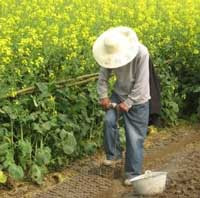 By ADRIAN ELY, STEPS Centre member
By ADRIAN ELY, STEPS Centre member
See more photos from this project on our Flickr site
The oilseed flowering season is almost over in central China, and cotton planting has started. Farmers first grow seedlings in nursery patches on the sides of their fields, before transplanting to a larger area after oilseed has been harvested. We spoke to dealers and farmers in Hubei province to ask about the decisions they face at this time of year. (Photo: Farmer planting nursery, Hubei / Adrian Ely)
One of the most important choices facing farmers is the selection of seed, and the reform of China’s cottonseed sector has delivered a bewildering wave of new offerings to farmers. The arrival of new technologies such as genetically-modified Bt cotton offers the promise of more secure yields and lower insecticide costs, at the same time making seed selection a more uncertain activity, especially in the presence of counterfeits and variable quality. Often farmers will spread the risk of crop failure by planting some of the latest varieties which promise higher yields, whilst also dedicating some of their land to older, trusted varieties that they have grown in previous seasons.
One of the main sources of information for farmers is through the agricultural extension service, which in many places overlaps significantly with the private seed distribution system. This shop is owned by Mr Zhang, who has been providing advice to local farmers for 21 years. He established the store just last year in order to secure a steady income for himself and his family in the face of public sector agricultural reforms.
Advice given to farmers may be based on local experience, the availability and commercial advantages (to dealer and/or farmer) of certain varieties, or on official data. Seed varieties are trialled by the Ministry of Agriculture at the provincial and county levels, and the results used to recommend specific varieties to farmers through television, radio and posters such as this one.
This blog is part of the STEPS Centre’s Rethinking Regulation project, looking at seed and drug regulation in China and Argentina.